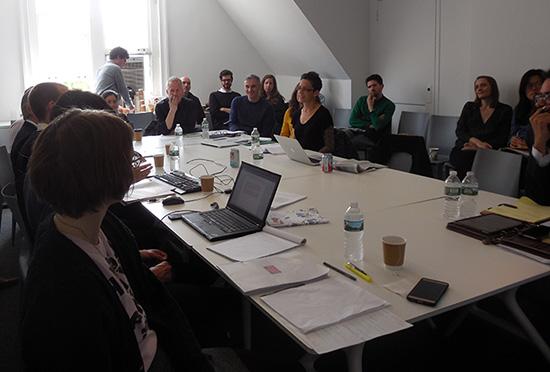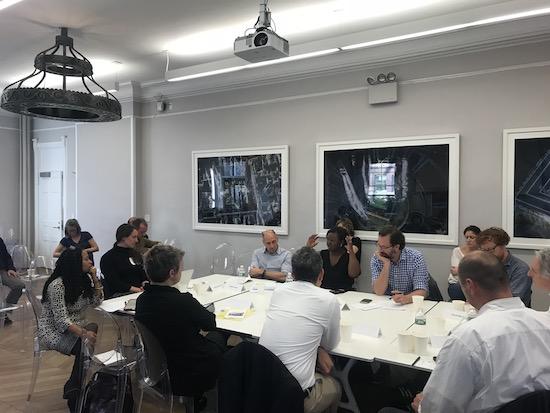Infrastructure in
America
Infrastructure and Emergency Powers Workshop
Infrastructure and Emergency Powers Workshop
May 12, 2017 5:30pm
Buell Hall 300S, Columbia GSAPP
On Friday, May 12th, 2017, the Temple Hoyne Buell Center for the Study of American Architecture hosted a workshop on "Infrastructure and Emergency Powers" as a part of its research project "Power: Infrastructure in America." As one initial line of inquiry, the Buell Center was interested in the way that infrastructural crises, often associated with economic distress and dispossession, articulate with the suspension of democratic institutions, as in the use of “emergency managers” in Flint, Detroit, and other municipalities. The closed-door workshop was organized to discuss key issues across disciplines, as well as intellectual and institutional strategies for studying these processes and drawing greater public attention to their implications.
Participants included Stephen Collier (International Affairs, New School, co-editor, Limn), Molly Cunningham (PhD candidate, Anthropology, University of Chicago), Lucas Owen Kirkpatrick (Urban Sociology, Southern Methodist University), Louise Seamster (Postdoctoral Fellow, Sociology, University of Tennessee), and Jason Stanley (Philosophy, Yale University).
Infrastructure and Emergency Powers Workshop, Michigan
In collaboration with the Taubman College of Architecture and Urban Planning at the University of Michigan and Louise Seamster at the University of Tennessee, Knoxville, this conversation took on some of the issues presented in an affiliated panel on emergency management held on February 22, 2018 in Detroit, considering emergency management as not only a local but also a national project, which engages with systems of infrastructure, government, and culture at multiple scales.
Schedule:
9:30 — Coffee
10:00 — EMERGENCIES
- Curt Guyette, ACLU of Michigan
- Tom Stephens, Detroiters Resisting Emergency Management
- Juanita Henry, City Commissioner, Benton Harbor
10:30 — Discussion
11:15 — HISTORIES
- June Manning Thomas, the University of Michigan
- Peter Hammer, Damon J. Keith Center for Civil Rights, Wayne State School of Law
- Dana Kornberg, The University of Michigan
11:45 — Discussion
2:00 — SYSTEMS
- The Temple Hoyne Buell Center for the Study of American Architecture, Columbia University
- Danielle Purifoy, Duke University
- Tawana Petty, Petty Propolis
2:30 — Discussion
3:15 — Full-group discussion
4:00 — Conclusion
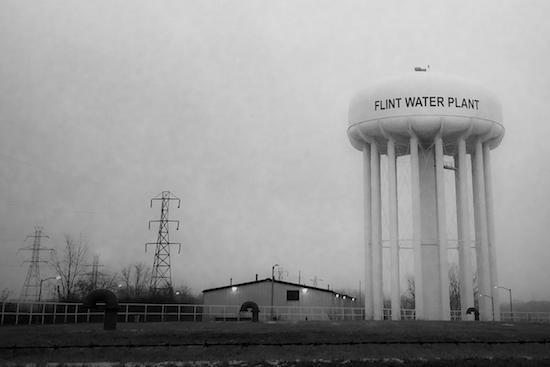
(Perry Rech/American Red Cross)
Juanita Henry speaks to the group
Climate, Infrastructure, and Emergency Powers Workshop
On Friday, April 13, 2018 the Temple Hoyne Buell Center for the Study of American Architecture hosted a workshop on "Climate, Infrastructure, and Emergency Powers" as a part of its "Power: Infrastructure in America" research initiative. While recognizing the necessity for emergency preparedness under constitutional democracy, one can nonetheless acknowledge that infrastructural crises associated with climate-related events have increasingly become the basis for the suspension or undermining of democratic institutions and the dramatic reshaping of environments, as in the case of New Orleans after Hurricane Katrina, Puerto Rico after Hurricane Maria, and possibly Houston after Hurricane Harvey, among others. Invited workshop guests discussed this and related ecological, spatial, and political issues across disciplines, as well as intellectual and institutional strategies for studying these processes and drawing greater public attention to their implications.
Participants included Fallon Samuels Aidoo (University of New Orleans), Daniel A. Barber (University of Pennsylvania), David Bond (Bennington College), Ashley Dawson (Princeton Environmental Institute), Anthony Fontenot (Woodbury University), Andy Horowitz (Tulane University), Andrea Muehlebach (University of Toronto), Cassandra Shepard (Northwestern University), Albert Pope (Rice University), and Abby Spinak (Harvard University).
The Green New Deal: A Public Assembly
On Sunday, November 17, 2019, at the Queens Museum, “The Green New Deal: A Public Assembly” gathered a wide array of advocates, organizers, and elected officials to explore the GND’s relationship to society, policy, and the built environment.
Climate change is a crisis of unevenly experienced and systemic injustices that asks hard questions of scholars, practitioners, and community members alike. The Green New Deal—most famously as drafted in US H. Res. 109 and S. Res. 59, but echoed by elected officials and activists around the world—addresses these questions head-on, linking equity, the environment, and the economy to the transformations necessitated by the climate crisis.
“The Green New Deal: A Public Assembly” focused on modeling democratic debates that seriously consider the ambitions and challenges of the GND by thinking systemically and across scales. The public event included morning workshops and an afternoon series of discussions to encourage exchange among invited guests representing a range of disciplines as well as the general public. Spanish interpretation services were provided for the afternoon assembly, beginning at 1:00pm.
Located at the Queens Museum—home of the Panorama of the City of New York and in the heart of the nation's most diverse county—“The Green New Deal: A Public Assembly” took place within US Congressional District NY 14, jurisdiction of the Green New Deal House Resolution’s sponsor, Representative Alexandria Ocasio-Cortez, who joined the assembly with a pre-recorded video.
The representative from NY-14, Alexandria Ocasio-Cortez, responded to three questions posed to all event participants.
The event was organized by the Queens Museum, the American Institute of Architects New York (AIA New York), the Architecture Lobby, Francisco J. Casablanca (founder of the Instagram page "¿Quién Nos Representa?"), and Gabriel Hernández Solano (a Green New Deal Organizer), together with the Temple Hoyne Buell Center for the Study of American Architecture at Columbia University. At the Buell Center, “The Green New Deal: A Public Assembly” formed part of the project “Power: Infrastructure in America,” within which the Center organized a series of research, curriculum, and programming initiatives to consider the social, technical, and political contours of the ambitious—but still largely undefined—proposal.
Schedule
10:00 Welcome / Bienvenida
10:30–12:00 Workshops / Talleres
1:00 Welcome (back) / Segunda bienvenida
- Language Justice Orientation by Caracol Language Coop
- Land Acknowledgment by Tecumseh Caesar
- Debra Wimpfheimer (Chief Operating Officer, Queens Museum)
1:15 On a Green New Deal / Sobre un Green New Deal
- Randy Abreu, Office of Representative Alexandria Ocasio-Cortez
2:00 On Energy and Power / Sobre energía y poder
Presentation by morning discussion group
- Samantha Josaphat (National Organization of Minority Architects)
- Forrest Meggers (Architecture and Engineering, Princeton University)
- Priya Mulgaonkar (New York City Environmental Justice Alliance)
- Matt Peterson (Woodbine)
- Anandi A. Premlall (educator in urban permaculture, SustyQ)
- Gaya Sriskanthan (climate, energy, and environmental justice advocate)
- Sean Sweeney (Labor and Urban Studies, City University of New York)
- Claudia Zamora Valencia (New Immigrant Community Empowerment)
2:20 Remarks by Costa Constantinides (City Council, 22nd District)
2:30 Public discussion
3:00 On Transportation and Power / Sobre transportación y poder
Presentation by morning discussion group
- Ellis Calvin (Regional Plan Association)
- Jon Forster (organized labor policy advocate)
- Oscar Oliver Didier (New York City Department of City Planning, the Bronx)
- Leah Meisterlin (Urban Planning, Columbia University)
- Juan Restrepo (Transportation Alternatives Queens)
- Jennifer Scarlott (Bronx Climate Justice North)
3:20 Remarks by Catalina Cruz (State Assembly, 39th District)
3:30 Public discussion
4:15 On Government and Power / Sobre gobierno y poder
Presentation by morning discussion group:
- Xiye Bastida (Fridays for Future)
- Tecumseh Ceaser (artist and cultural consultant)
- Ama Francis (Sabin Center, Columbia University)
- Diana Hernández (Public Health, Columbia University)
- Aurash Khawarzad (artist, educator, urban planner)
- Monxo Lopez (South Bronx Unite)
4:35 Remarks by Jessica Ramos (State Senator, 13th District)
4:45 Public Discussion
5:15 Concluding remarks and discussion / Conclusión, comentarios y discusiones
6:00 Reception / Recepción
---
“The Green New Deal: Una Asamblea Pública” convocó una selección amplia de especialistas, organizadores, y oficiales elegidos para explorar la relación entre el "Green New Deal," la sociedad, la política, y el ambiente construido.
El cambio climático, siendo una crisis desigual y de injusticias sistemáticas, es un desafío lleno de interrogantes, tanto para académicos, profesionales, y miembros de la comunidad por igual. El Green New Deal—mejor conocido por su redacción en US H. Res. 109 y S. Res. 59, y que resuena con los oficiales elegidos y activistas alrededor del mundo—aborda esas preguntas de una forma directa, enlazando la equidad, el medio ambiente, y la economía a las transformaciones necesarias para enfrentar crisis climática.
“The Green New Deal: Una Asamblea Pública” se enfocó en modelar debates democráticos que consideran seriamente las ambiciones y los retos del GND, pensando sistemáticamente y en varias escalas. Este evento público incluyó talleres de trabajo en la mañana, en la tarde y una serie de discusiones para fomentar un intercambio productivo entre los invitados de distintas disciplinas y el público general. Se proveyó servicios de interpretación en español para la asamblea de la tarde, comenzando a las 13:00.
Al estar ubicado en el Museo de Queens—situado en el corazón del condado más diverso del país y donde podemos encontrar la maqueta “Panorama of the City of New York”—“The Green New Deal: Una Asamblea Pública” se llevó a cabo dentro del Distrito NY 14 del Congreso de los Estados Unidos, jurisdicción de la patrocinadora de la Resolución del Green New Deal, la Representante Alexandria Ocasio-Cortez, quien se unió a la discusión por un video pre-grabado (arriba).
Este evento estuvo organizado por el Museo de Queens, el Instituto Americano de Arquitectos de Nueva York (AIANY), el Lobby de Arquitectura, Francisco J. Casablanca (fundador de la página de Instagram "¿Quién Nos Representa?"), y Gabriel Hernández Solano (organizador del Green New Deal), en conjunto con el Temple Hoyne Buell Center for the Study of American Architecture en Columbia University. En el Buell Center, “The Green New Deal: Una Asamblea Pública” formó parte del proyecto “Power: Infrastructure in America” (Poder: Infraestructura en América), dentro del cual el Centro organizó una serie de iniciativas curriculares, investigativas, y programáticas que consideran los entornos sociales, técnicos, y políticos de una propuesta ambiciosa, pero en gran parte indefinida.
Horario arriba
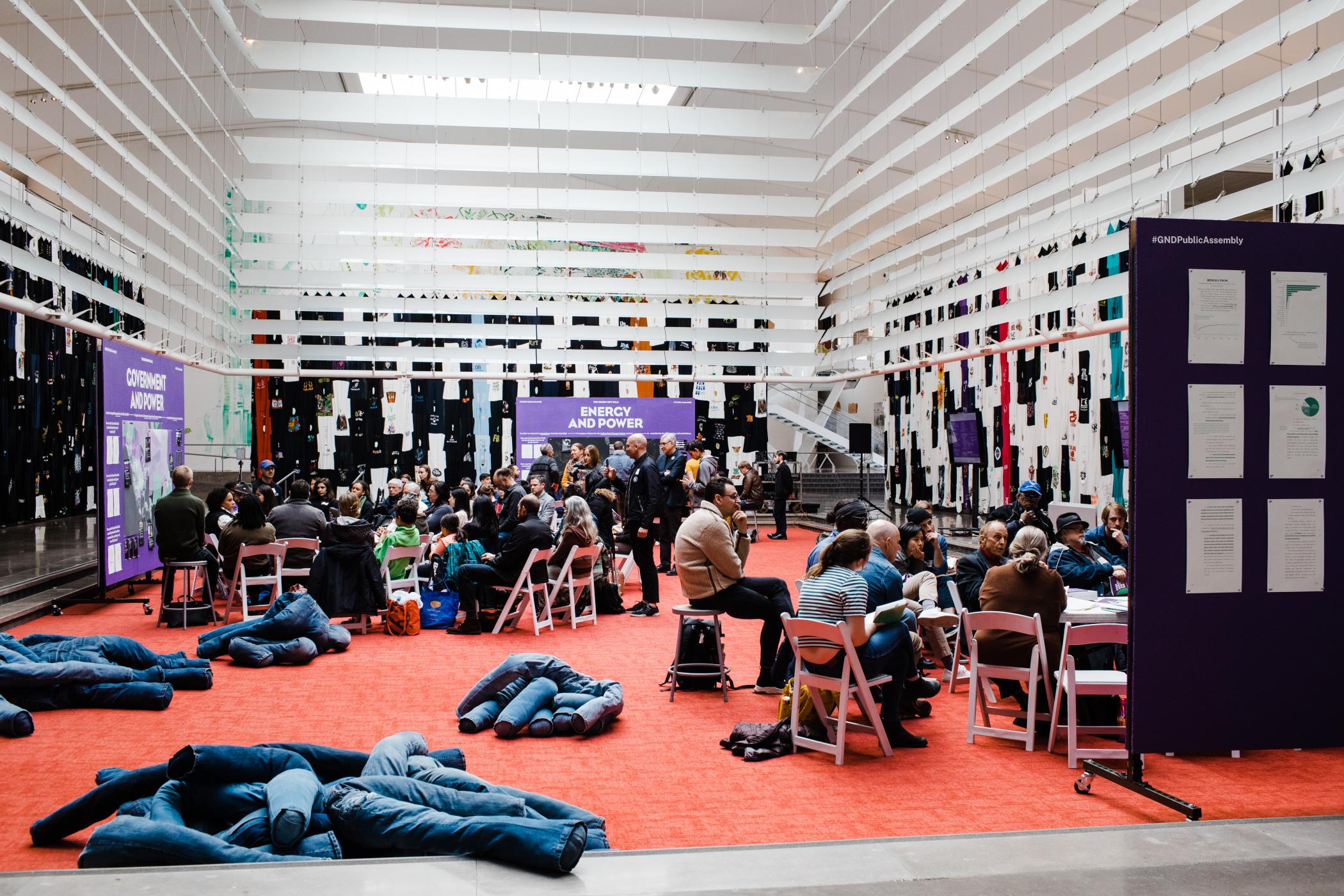
"Green New Deal: Public Assembly" (Corey Torpie)
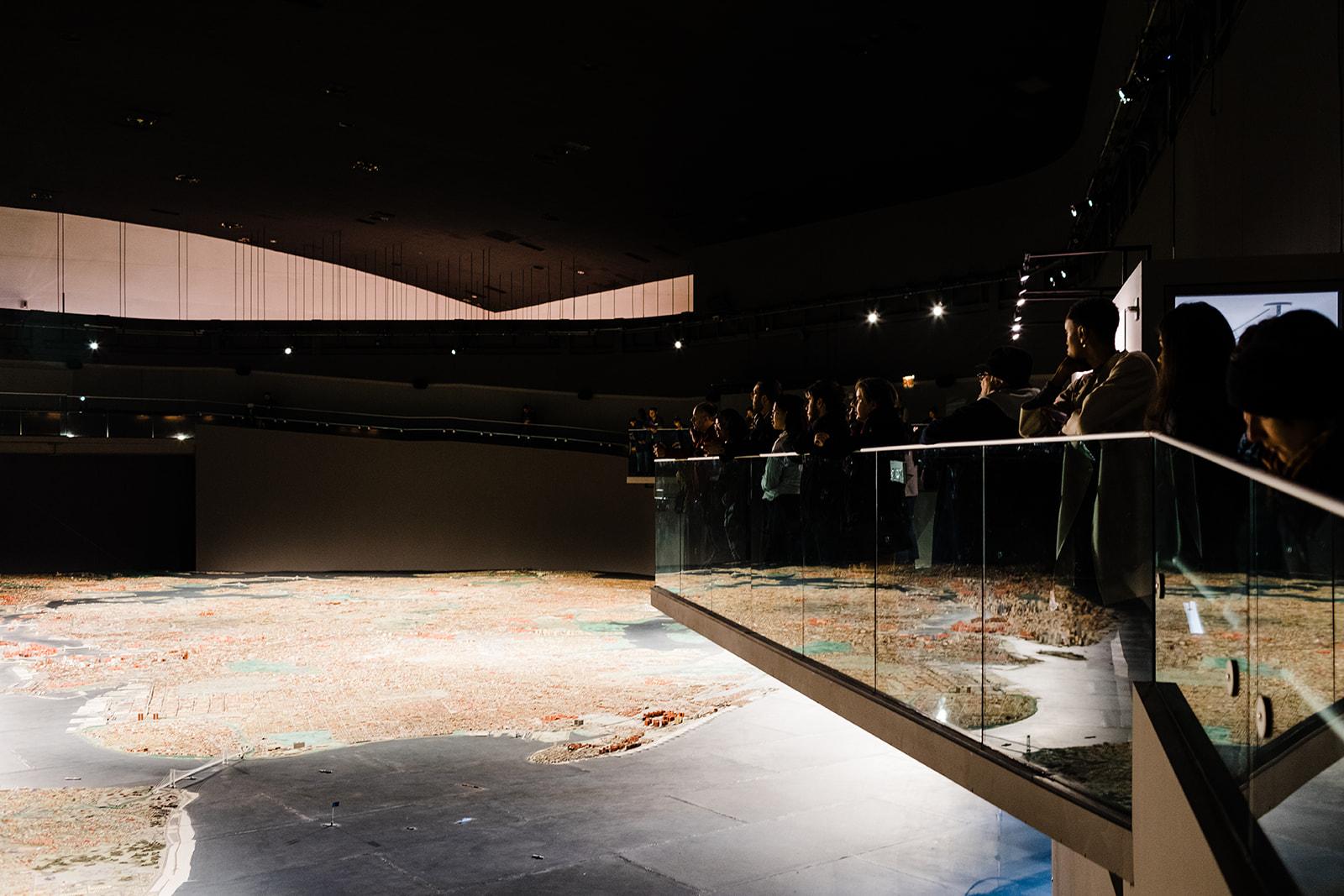
"Green New Deal: Public Assembly" begins around a Panorama of the City of New York (Corey Torpie)
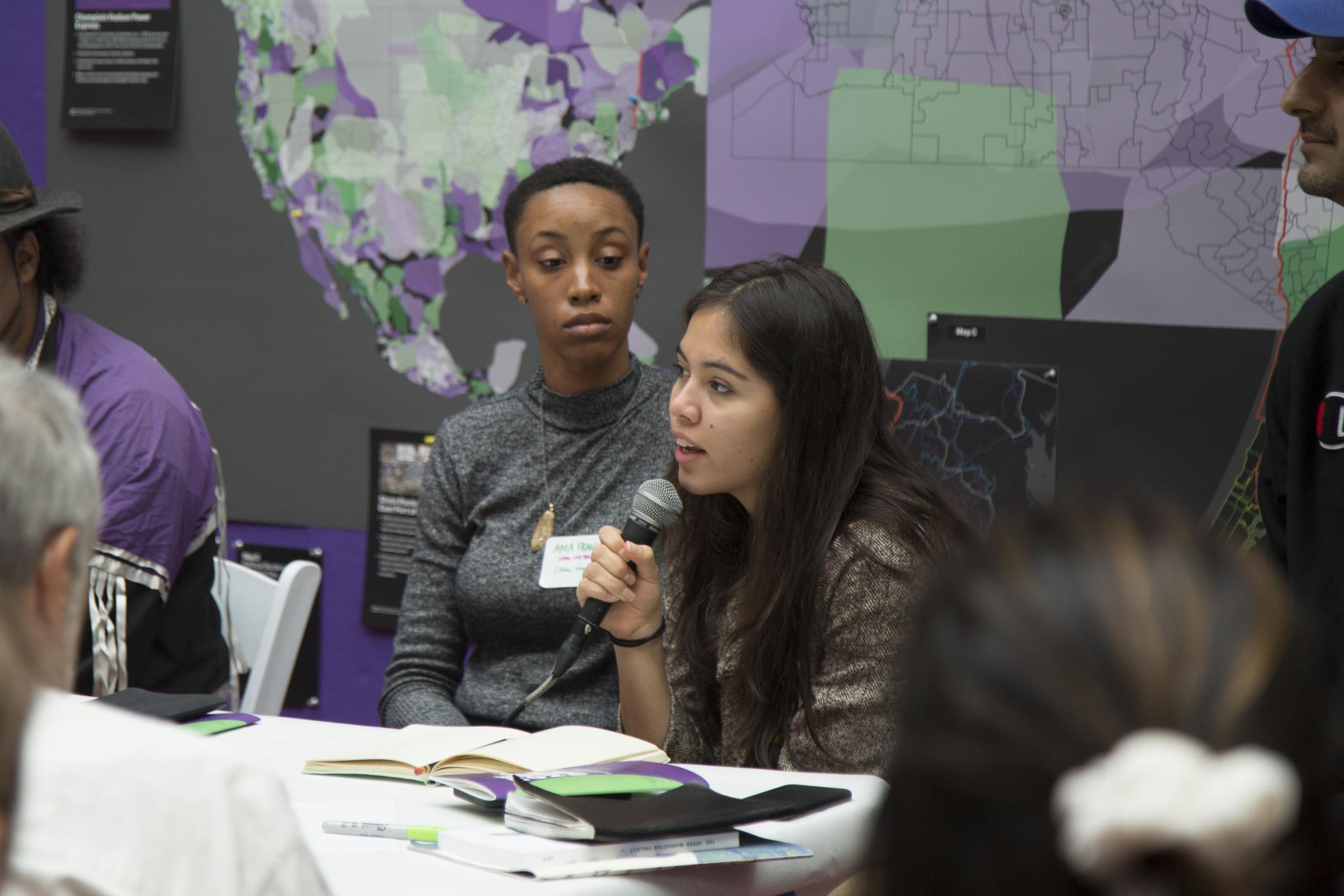
Xiye Bastida participates in the "Democracy and Power" workshop (Claudia Kleffmann)
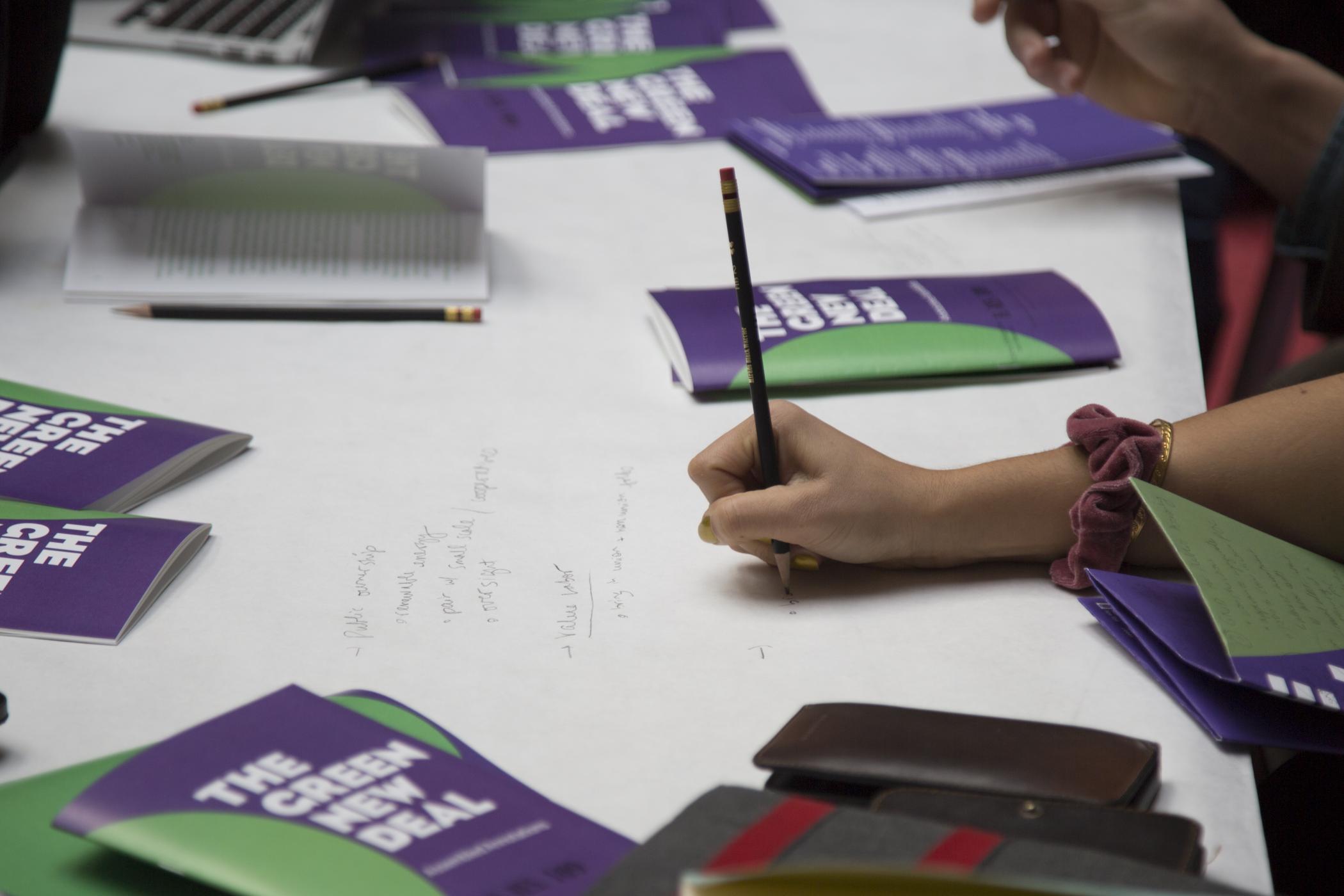
Workshop participants taking notes alongside "The Green New Deal: Assembled Annotations" (Claudia Kleffmann)
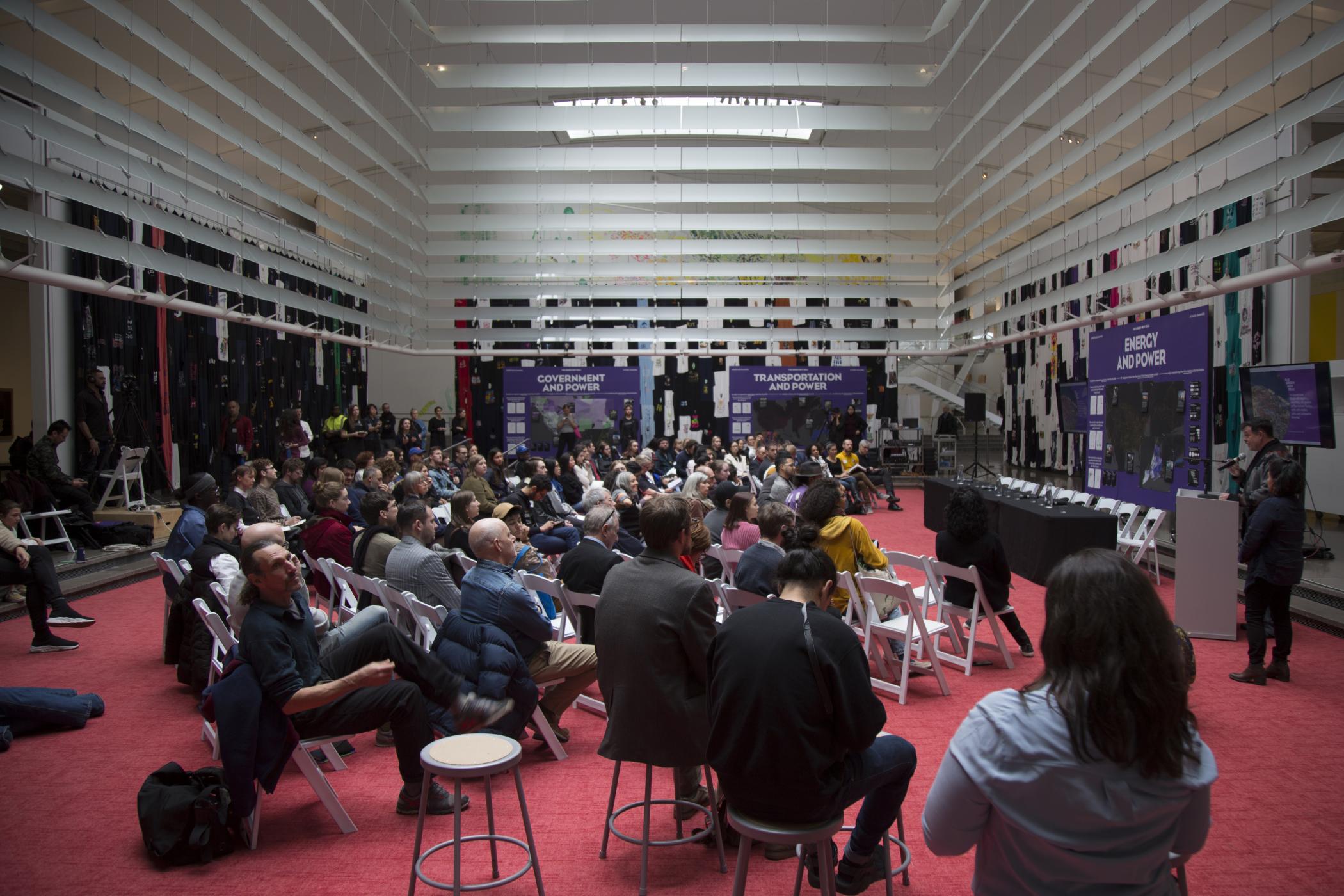
Caracol Language Cooperative gives a language justice orientation (Claudia Kleffmann)
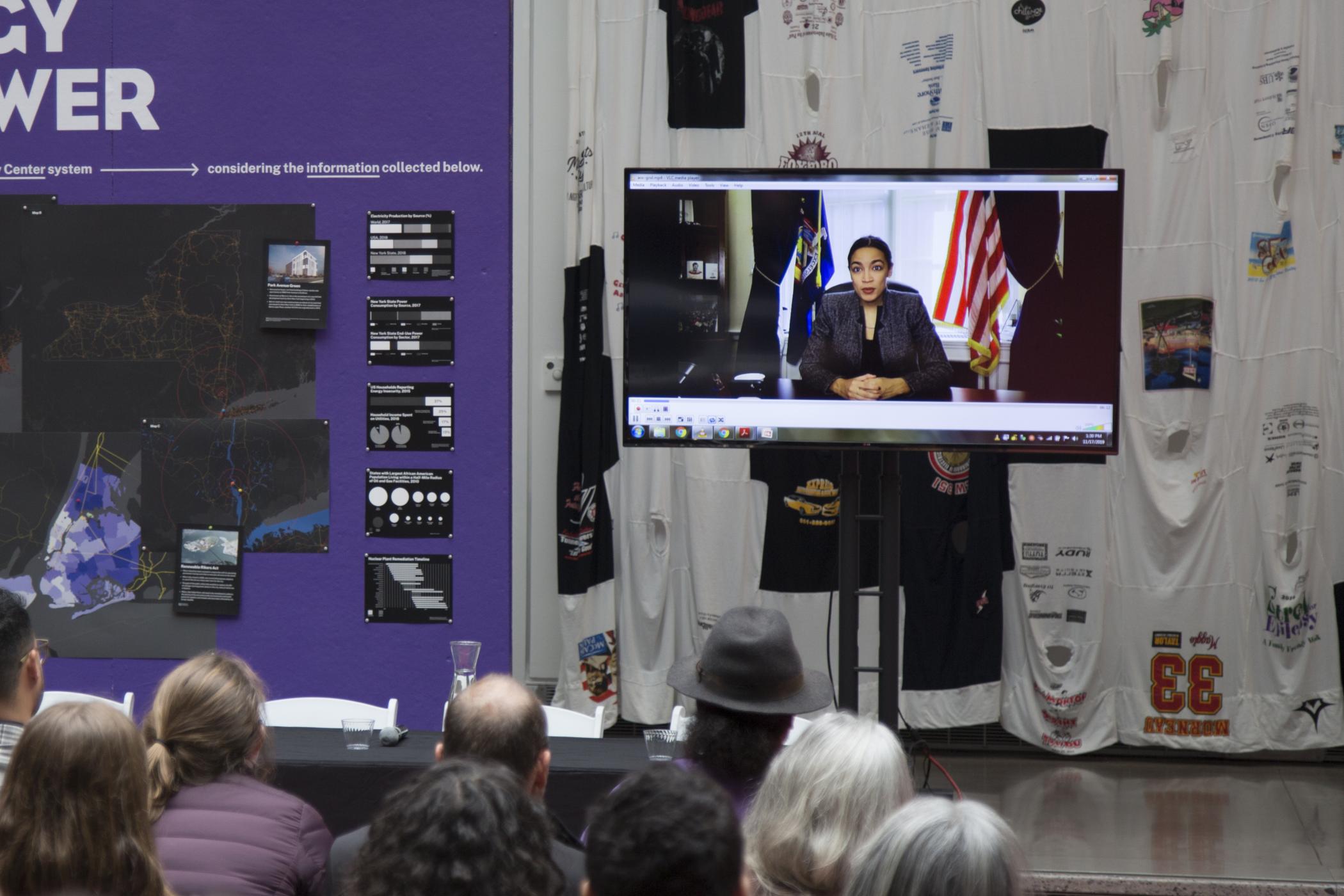
Representative Alexandria Ocasio-Cortez addresses the audience (Claudia Kleffmann)
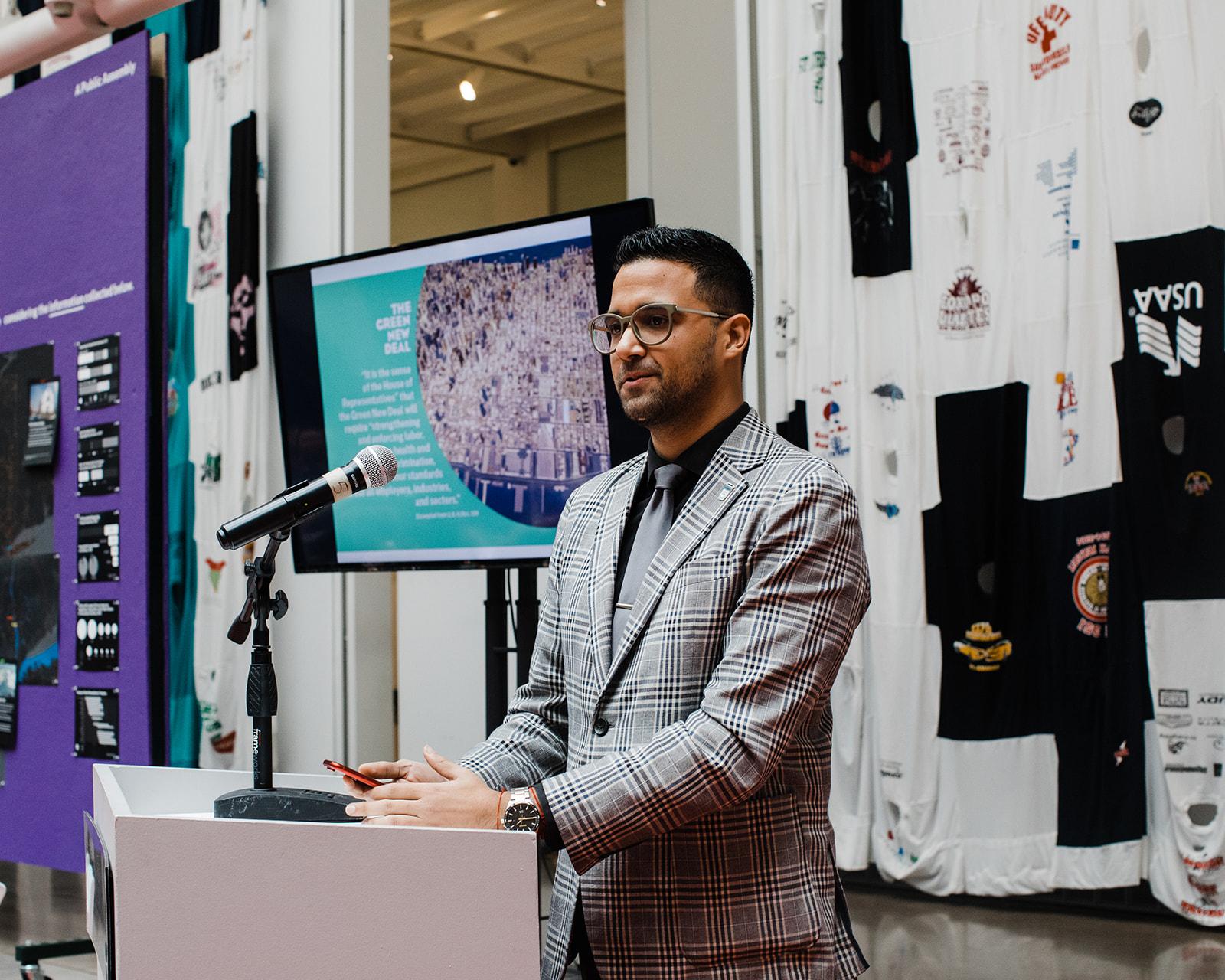
Andy Abreu discusses a Green New Deal (Corey Torpie)
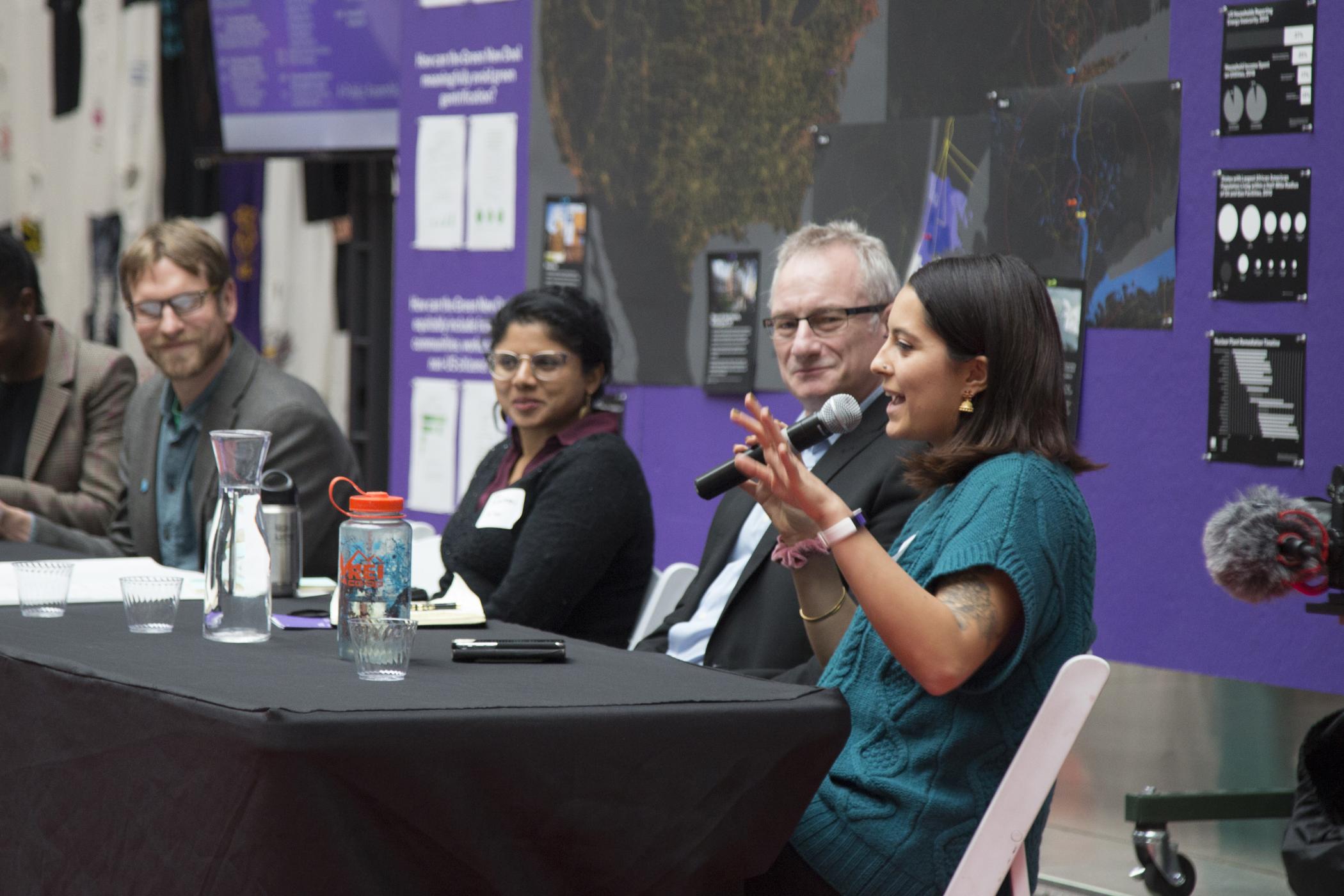
Priya Mulgaonkar on "Energy and Power" (Claudia Kleffmann)
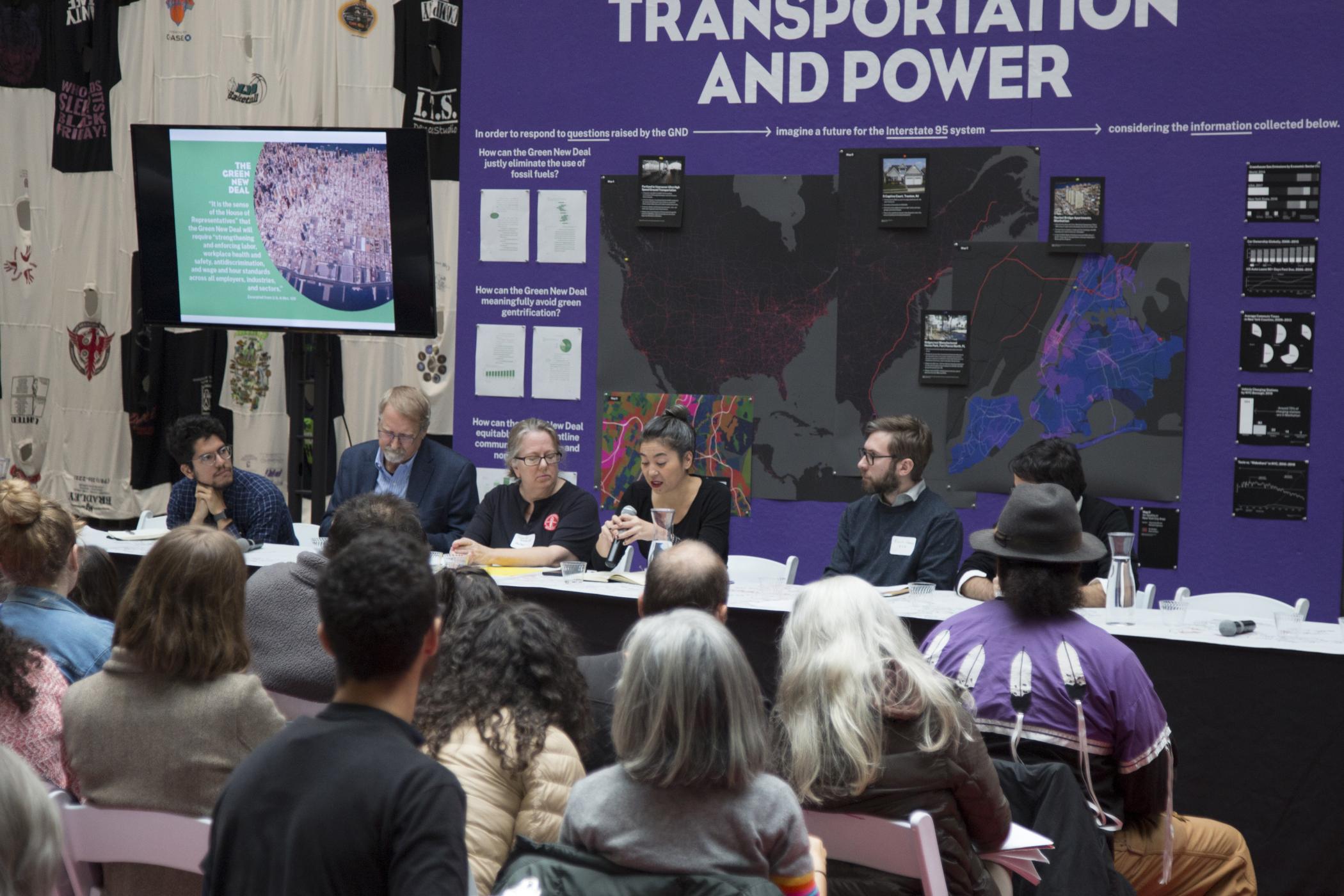
Leah Meisterlin discusses "Transportation and Power" (Claudia Kleffmann)
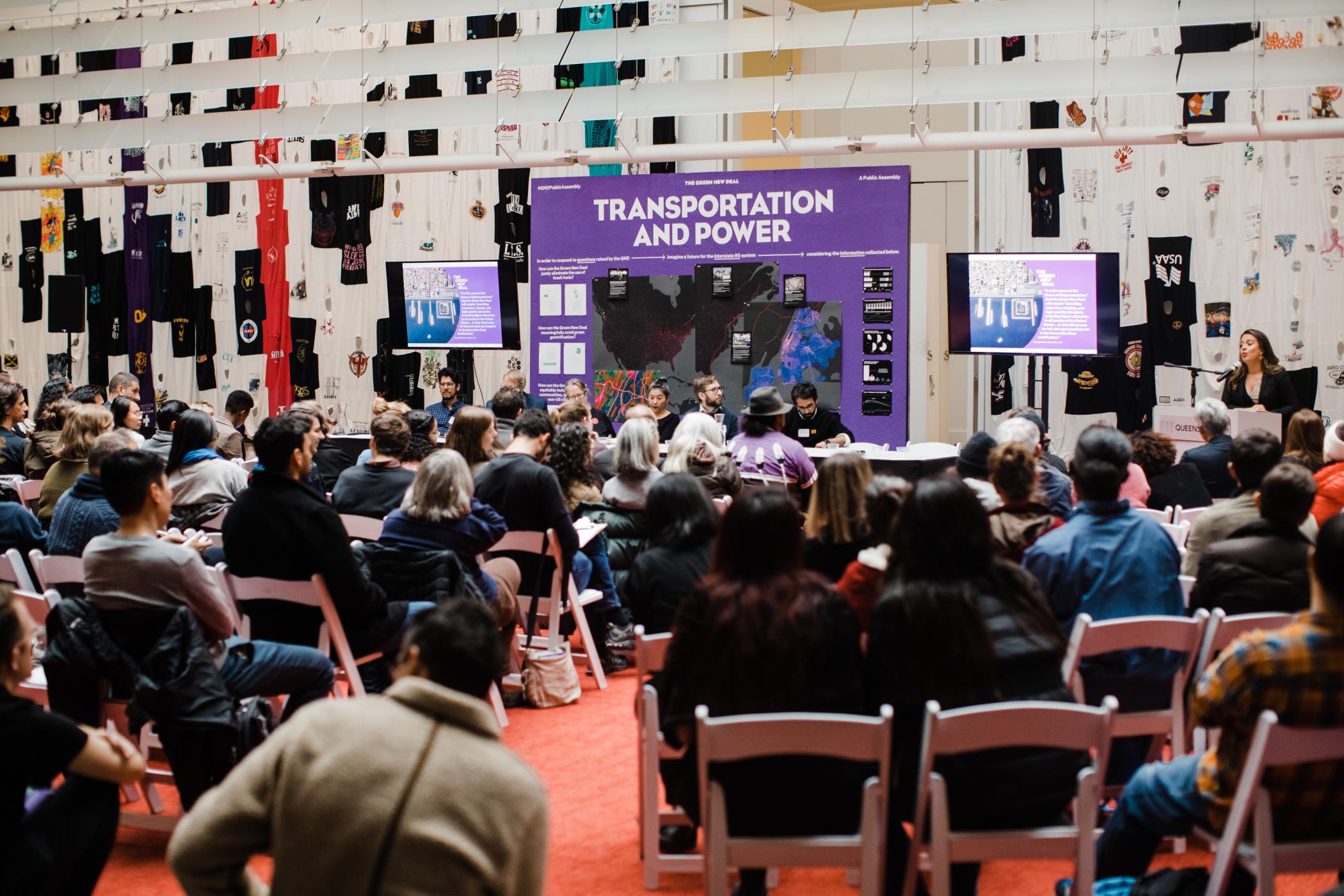
Assemblywoman Catalina Cruz on "Transportation and Power" (Corey Torpie)
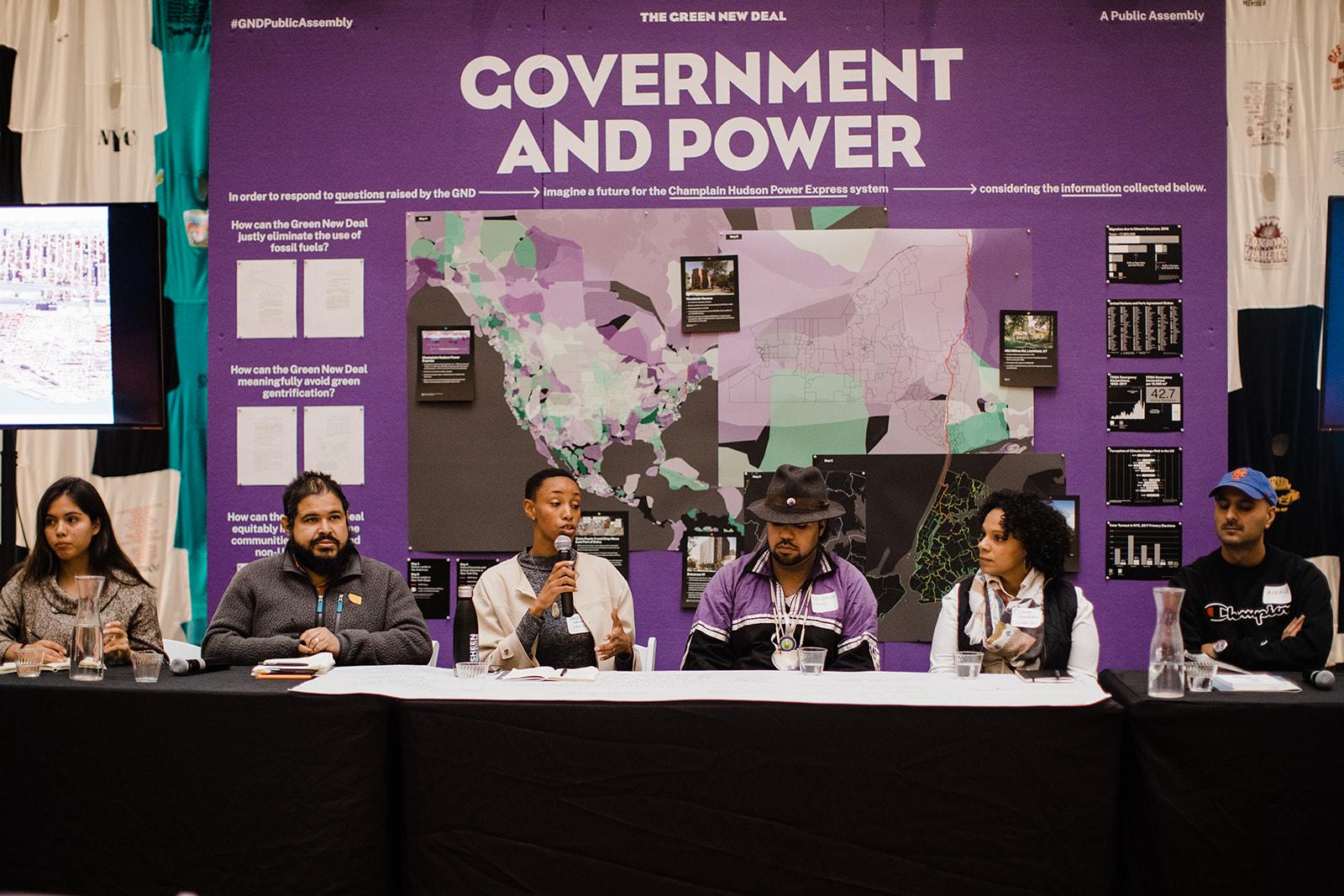
"Government and Power" (Corey Torpie)
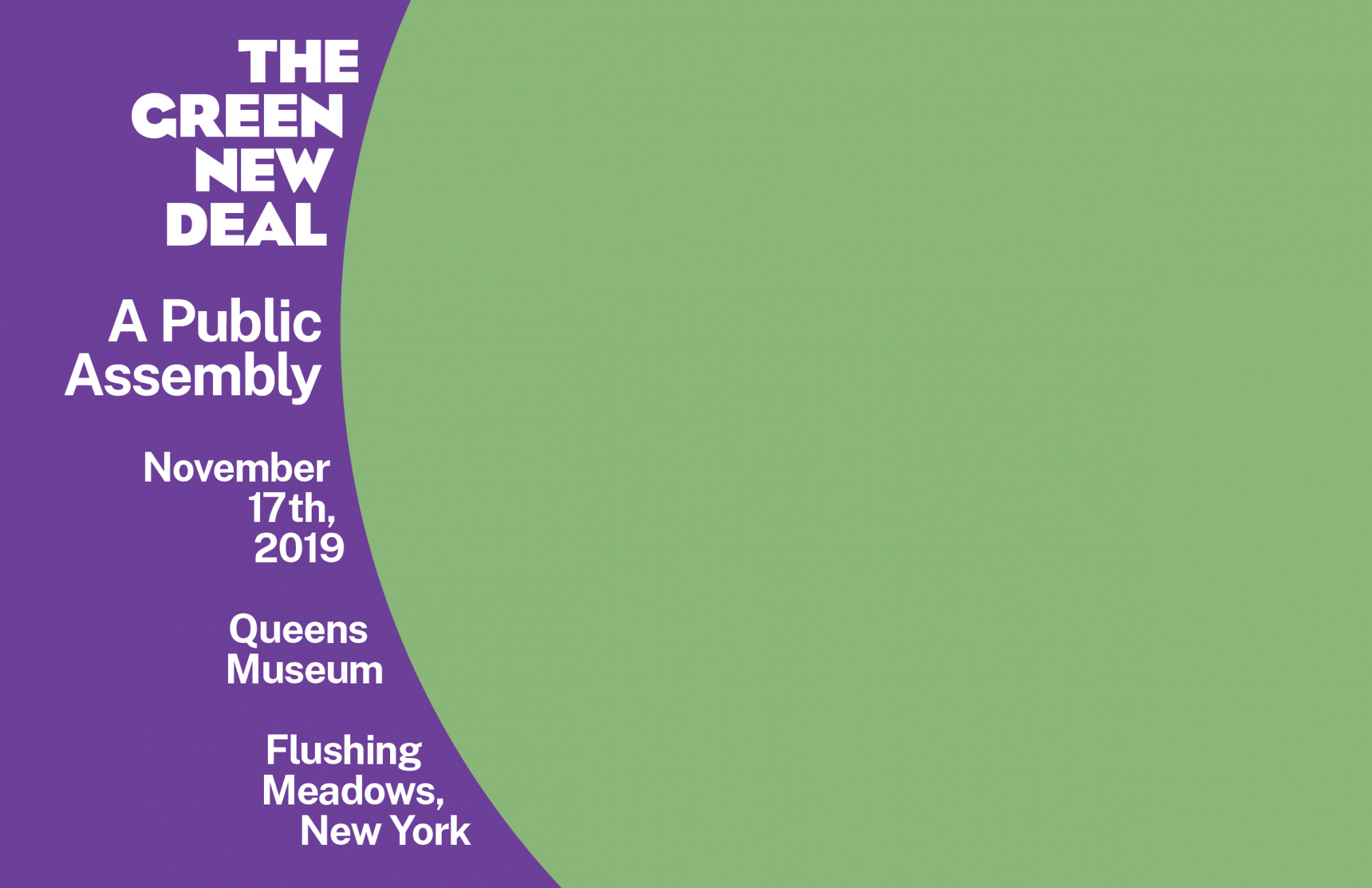
Nationalism, Aesthetics, and Emergency Powers Workshop
Nationalism, Aesthetics, and Emergency Powers Workshop
April 14, 2018
East Gallery, Buell Hall
On Saturday, April 14, 2018, the Temple Hoyne Buell Center for the Study of American Architecture hosted a workshop on "Nationalism, Aesthetics, and Emergency Powers" as a part of its "Power: Infrastructure in America" research initiative. This formed part of a project to bring together scholars with expertise in the roles played by architecture, the visual arts, and urbanism in the production, articulation, and dissemination of nationalist or ethno-nationalist programs. Historical scholarship in architecture and the visual arts has long addressed such matters. Yet, critical, public discussion of the aesthetics of nationalism—and of the more general aestheticization of politics—remains relatively scarce. This workshop therefore aimed, comparatively and collaboratively, to call attention to this question at a time when such discussion is especially urgent in the United States as well as worldwide.
Participants included Esra Akcan (Cornell University), Can Bilsel (University of San Diego), Mia Fuller (University of California, Berkeley), María González Pendás (Columbia University), Lucy Maulsby (Northeastern University), Brian L. McLaren (University of Washington), David Rifkind (Florida International University), Mabel O. Wilson (Columbia University), and Claire Zimmerman (University of Michigan).
Green Reconstruction Curricular Workshop
On July 30, 2020 twenty-six teachers from professional schools in the built environment gathered virtually with the Buell Center and additional faculty from Columbia GSAPP for an online workshop on "Green Reconstruction" that studied the interconnectedness of today's crises of care, political economy, and climate—emphasizing the pervasive force of racial capitalism throughout—to imagine what a genuinely system-wide response must entail.
Acknowledging that the participants were likely even busier than usual this particular summer given the confluence and concentration of crises, all nonetheless shared a commitment to action. As befits academic work, the actions proposed and discussed in the workshop were mostly long-term and entailed step-by-step deliberation. The focus was on professional education in the built environment, with an emphasis on architecture, landscape architecture, and urban planning. The aim was and remains collaborative curricular transformation on a national scale.
The Buell Center laid the groundwork for the workshop empirically, with a team of nine graduate students documenting professional and pre-professional curricula at all Association of Collegiate Schools of Architecture (ACSA), American Society of Landscape Architects (ASLA), and American Planning Association (APA) member institutions. A summary of that student-led work is visible here. Also foundational was an influential article by the sociologist Nathan Glazer, “The Schools of the Minor Professions,” from 1974. In it, Glazer classified urban planning and, in a qualified sense, architecture, as “minor” in relation to the classically “learned” professions of law, medicine, and divinity. Participants referred to this anachronism as leverage, a way to elevate the responsibilities of their collective fields in building, administering, and transforming the social contract from below established discourse, through the day-to-day pedagogical work of changing imaginations and changing practices.
The model was the “public assembly” that the Buell Center co-convened in fall 2019 at the Queen Museum to test concretely the local implications of the Green New Deal. Where that event centered local environmental justice activists, policy advocates, and academics, and included a participant audience of hundreds, this “Green Reconstruction” workshop was limited to a group of colleagues in architecture, landscape architecture, and urban planning from across the country. Borrowed from the earlier assembly was a two-part structure, adapted to Zoom, of smaller, thematically organized breakout groups followed by a larger plenary session.
For each the three groups, the Buell Center Graduate Research Assistants offered a thematic focus based on specific information drawn from the aforementioned survey of over a thousand professional, pre-professional, and post-professional programs in the built environment across the United States. These themes and the case studies that accompanied them were prompts, offered to focus discussion and generate responses.
PROFESSIONALIZATION
The first breakout group discussed the notion of professionalization as it shapes and is shaped by curricula of the built environment. Students in all programs, while bearing the typically high costs of education, experience the often competing pressures of “core” requirements, “elective” specializations, software and skill competencies, and the idea of self-marketability once they enter the workforce. In all of this, individual professionalisms of various types tend to take precedence over collective responsibilities toward the public good. How much of curricular decision-making is directed by accreditation processes, private firms, and industry interests, as compared to other forces “inside” the fields’ study?
Led by Graduate Research Assistants Irina Chernyakova, HK Dunston, and Max Goldner, the group discussed these questions through three lenses: extending education and specialization with secondary and dual degrees; software pedagogies with textbooks for introductory GIS courses; and orientation toward private and public work with professional practice courses. Discussants included Mason Andrews, Imani Day, Ross Exo Adams, Gabriel Fuentes, Kian Goh, Monxo López, Nicholas Pevzner, and Raphael Sperry.
RESEARCH
Ranging from architectural history to design to social science, "research" in schools of the built environment has a dynamic relationship with the communities with which it engages. The second breakout group focused on those research centers that interact with their institutions’ curricula by providing specialized masters, studio experiences, or otherwise “embedded” student projects. This intertwining of community and research involves the creation, transformation, and, in some cases, exploitation of communities. Led by Graduate Research Assistants Rosalie Singerman Ray, Andrés Julián Alvarez Davila, and Hayes Buchanan, the definition of community was left purposely broad, stretching from those formed around a single design-build project or neighborhood, to entire industries as they interact with state and national policymaking. How can these often narrowly construed efforts address systemic and historically determined challenges like climate change? How might engagement with diverse communities confront technocratic, racially biased legacies and suggest new forms of self-critical pedagogy? How does the creation of particular degrees or the propagation of particular research methodologies build communities of practice, and what implications do they have for engagement with the historically marginalized groups so often foregrounded in community research centers? The group explored these questions as they are made manifest via financial ties, “on the ground” infrastructure, and vehicles for self-propagation. Discussants included Aimi Hamraie, Farhan Karim, Nea Maloo, Khaled Mansy, Jeanne Homer, Juliana Maxim, Kiel Moe, Athar Mufreh, Marc Norman, and Quilian Riano.
GOVERNANCE
Breakout group number three discussed student and faculty governance as it impacts curricula of programs dealing with the built environment. Led by Graduate Research Assistants Henderson Beck, Malcolm Rio, and Anays Mical González Sánchez, the group defined governance as any form of student or faculty representation in the decision-making processes of an academic department, school/college, or university/institution. Despite some variability, the team found a strong correlation between the presence of student governance organizations and the presence of institutionalized faculty governance. Additionally, the team found a weaker correlation between the presence of student governance and faculty unionization. These correlations raised a number of questions: Does the presence of strong faculty and student governance organizations affect curricula? Does the presence of faculty, graduate, or undergraduate unionization affect or provide a model for other forms of faculty and student organizations? Do curricula impact how students organize and network after graduation? Do alumni frameworks buttress or contradict departmental mission statements? How do student governance and external collaboration efforts impact students’ relationship with the built environment and local community? The group discussed these questions through three lenses: faculty and student labor formations and curricular structures; alumni networks and their impacts on academic and professional development; and inter-institution collaborations driven through faculty or student efforts. Discussants included Fallon Samuels Aidoo, Gabriel Cuellar, Bradford Grant, Sophie Hochhäusl, Zachary Lamb, Ana María León, Ivonne Santoyo-Orozco, and June Williamson.
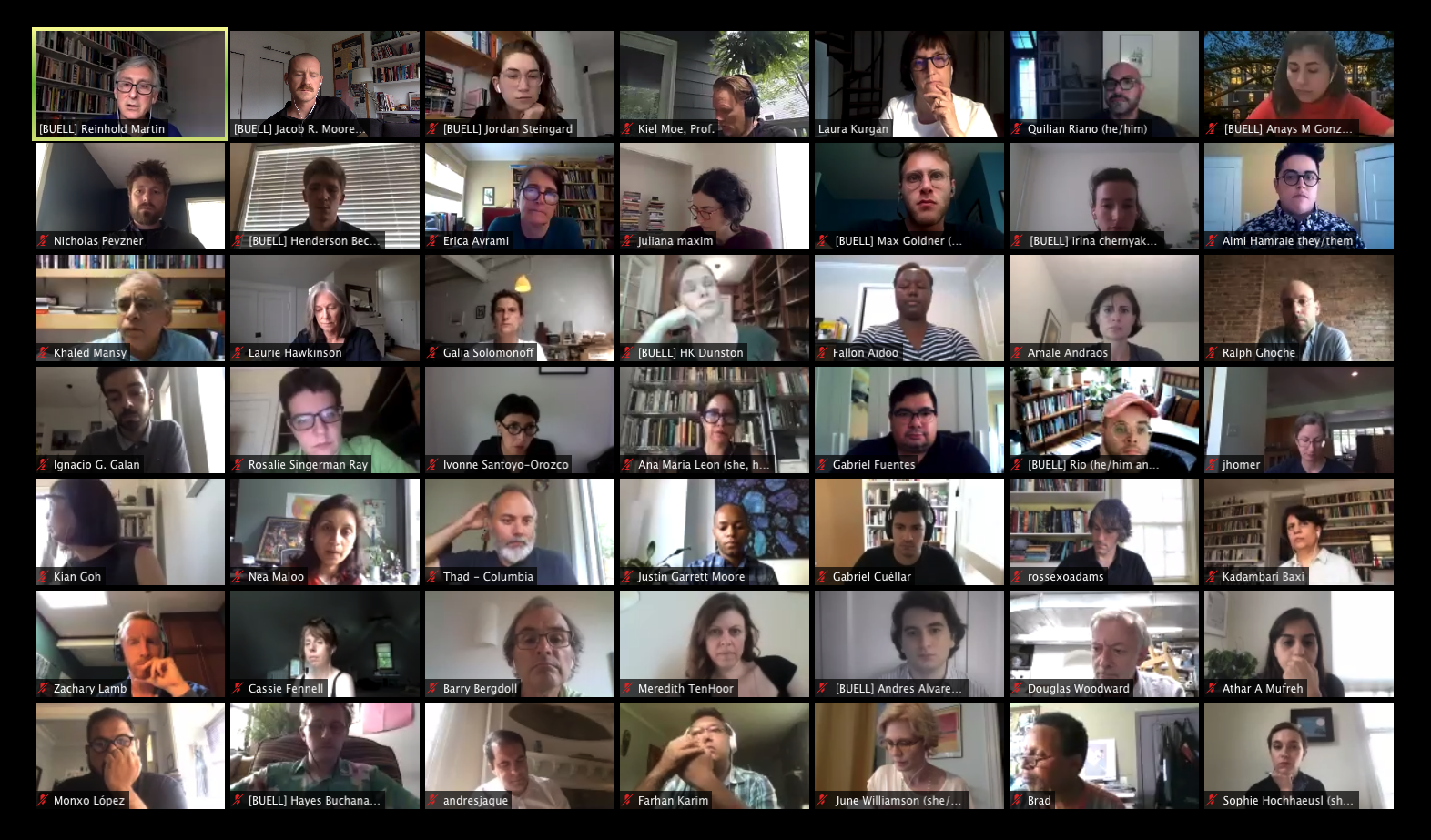
Green Reconstruction Curricular Workshop, Zoom, July 30, 2020 (Not all participants shown)
